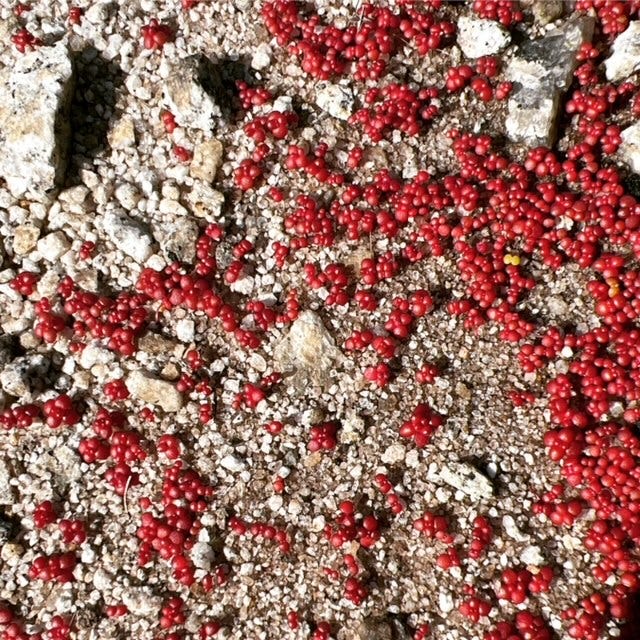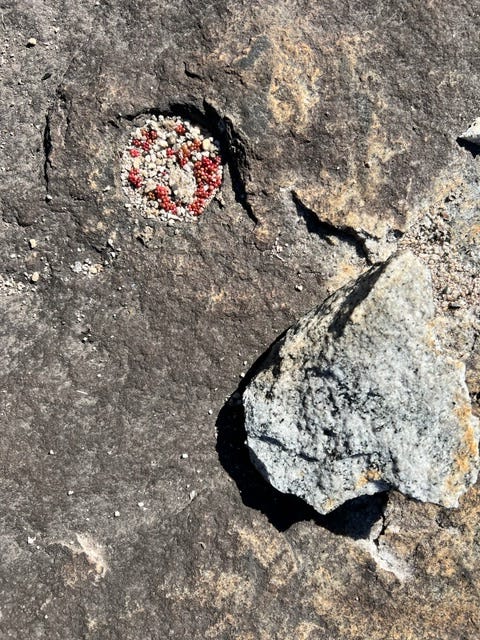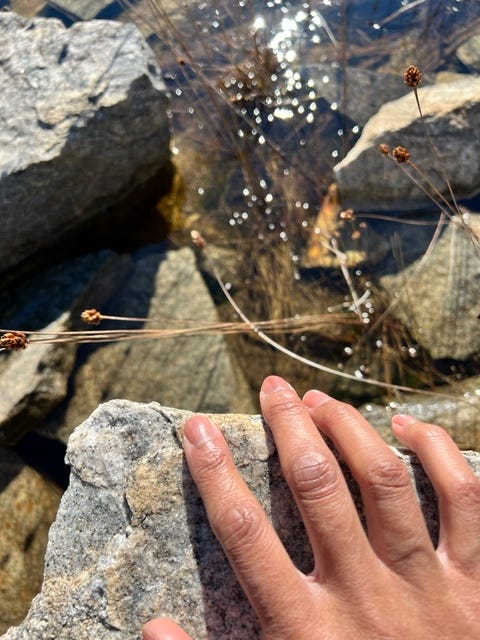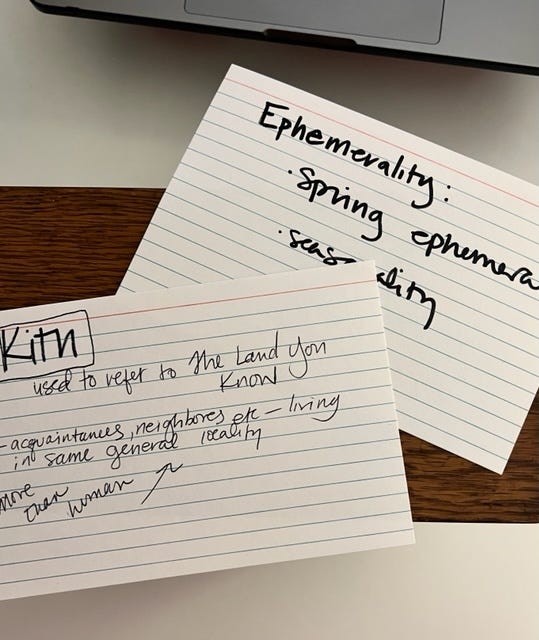What do you do when you feel carelessly handled, too tender, trod upon, or like you just don’t have enough time to get it together? I walk. What my soul needs is very often as simple as that and the best walks multi-task: exercise, immersion in the more than human natural, and opportunities to practice listening and seeing. One of my favorite place to walk is Davidson-Arabia Mountain Park. It’s about a twelve minute drive away ( this is practically nothing in Atlanta travel time) and is utterly beautiful.
Arabia Mountain contains a system of easy to moderate trails that weave through woods, and wetlands, including lakes, creek and stream habitats, as well as ghostly, abandoned structures once used by workers when it was an active quarry. Side note: over the course of 400 million years, that rock heated and expanded, swirled, then cooled and compressed. The geological processes it went through made it exceptionally strong and beautiful, with a distinctive pattern called Tidal Grey. It was used in buildings across the eastern seaboard.
I have spent many hours poking around Arabia’s pine and oak forests and I’ve heard it said that the nature-curious fall into one of two categories: those gazing ever skyward and those constantly scanning the ground. I’m sure there are other categories (there are never just two types of anything), but I live decidedly among the earth watchers (old school Virgo vibes). I’m a listener too, which means my gaze can be drawn upward, following a ripple of birdsong (and once my friend Sierra and I lost a close-quarters stare-down with a barred owl) but mostly, I’ll be looking down—for frogs, spotted salamanders, scaly rust gill, puffballs, turkey tail and so on. The forest floor is action.
The moonscape of Arabia’s exposed granite outcroppings provides a study in contrast to the leafy rot of its woods. My first few visits, in a rush to get to the familiar shelter of trees, I would use what I initially experienced as the bare rock of these monadnocks for the “exercise” part of my hike—speed walking the inclines, strategically leaping and climbing through rockier passages. Per park signage, I’d be careful to “stay on the grey” of the actual granite so as to avoid stepping in the shallow sandy dips and depressions that dot the mountainside. I knew this instruction had something to do with protecting the potential for plant life, but I’d always speed on.
One warm day though, not long after it had rained, I started up “the mountain side” to find every round and elliptical dip that was deep enough to contain more than a few centimeters depth of soil just riotous with bright yellow daisies and spotted phacelium. I think I may have cried a little it was such a joyous vision. That delight jolted me into paying better attention. Ever since then, I have lingered and marveled at the special nature of these ecoscapes, those little islands of plant life that dot the mountain. I now appreciate that even the dips that aren’t deep enough to nurse wild flowers (called solution pits) are also always full of life (this is why it’s important to stay on the grey!). The goings on in these sandy pits are small, complex beautiful, and fragile. Even a single person’s careless trodding could cause real damage to these subtle systems.
One of the Arabia Mountain Natural Heritage Area’s marketing taglines is “400 Million Years in the Making!” Indeed, one of the marvelous things about the park is the juxtaposition of scale and temporality. The landscape hosts all sorts of lichen, moss and tiny ephemerals often found in few other places on earth. One of my favorites, and kind of a celebrity in these parts is a tiny ripe berry-red succulent called diamorpha (Diamorpha smallii in fact, I kid you not). This beauty starts beading up in the late fall and spreads a red carpet over traces of the rock through the winter. In the spring it flowers—a pretty, white, four part corolla—and then it dies. Diamorpha, also known as elf orpine, needs very little soil—a mere 2-8 centimeters—and prefers to grow along the edges of moss communities but there are other rare ephemerals that call the solution pits home as well. Little amphianthus (Amphianthus pusillus) is a federally threatened aquatic herb found almost entirely in Georgia. Commonly referred to as pool sprite (or the less poetic snorklewort), amphianthus loves the sandy mineral-filled soils that collect in the solution pits and asks only for 1-4 inches of water in the weeks following a downpour in order to do its thing. Their entire life cycle usually lasts less than a month. During the summer months, when the pits and pools they love have dried up, they persist only as the tiniest seeds, barely distinguishable from the dust and dirt in which they wait.
The critically imperiled Black spored Quillwort (Isoetes melanospora) also lives in the muddy seeps and sandy solution pits on Arabia. It looks kind of like baby chives and, non-flowering, reproduces by spores produced in late spring that then set off with trickling of water or on insect wings. It is humbling to witness the cumulative cycles of plant succession in the solution pits and the way even the very small and ephemeral is essential. Lichen to moss to delicate ephemeral to bright yellow daisy and maybe back again. All as the soil builds or washes away with precious spring rain.
It’s easy to love Arabia Mountain’s outcroppings in the warm Georgia spring. Everything is blooming and for a while, per square foot, the butterfly count is among the highest in the country. But as the mountain continues to teach me how to see the small and at times invisible, it is the winter walks that fill me with wonder and hope. There is a kind of relational Baader-Meinhof phenomenon at play: by paying attention, I can not only spot and appreciate the tiny more frequently, I also see parallels. In the juxtaposition of temporalities—viewed against geological time, my own tender being is pretty ephemeral. A person may as well be an elf orpine for the difference it makes to a 400 million years old mass of granite. But I’m a part of it all, aint I? Walking the trails at Arabia, I feel connected to systems that extend my understanding of interconnected life cycles. And when I feel carelessly handled, stepped upon, or like I don’t have enough time to do what needs doing, I need only go for a walk on the moonscape twelve minutes away to remember that my blooming too, is ever-imminent.
Where are you walking these days? What are you learning to pay attention to?









Subtle Systems... and snorklewort. Reading your writing is a delight. Thank you. Sally
This is beautiful-- reading through I feel my breathing slow-- so much anxiety and shallow breaths these past few years. Life is short, way way way too short in most cases. It is easier I think to feel firmly held and woven into, if this size/perspective of elf orpine takes hold. Larger feels off kilter now somehow. And boy do I ever love the term "solution pit" !!! An invitation to look at aaalllll the growth exploding in the murky slime.....May you continue to feel/find this peace. Grateful reader here.